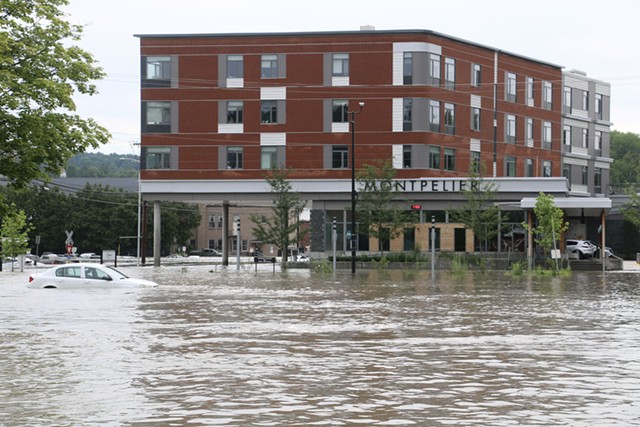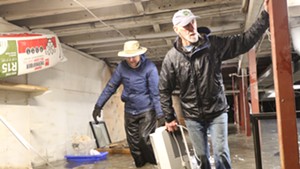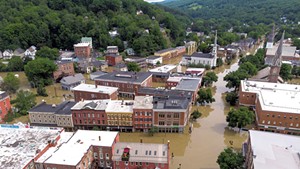
- Rob Donnelly
For decades, Vermont has tried to encourage housing development in downtowns and village centers to keep them vibrant, limit suburban sprawl, and protect farm and forestland. As incentives, the state has offered tax credits and streamlined permitting for developers who build in 274 designated areas.
The only problem: Most of those community centers sit on floodplains.
That presents a conundrum for state housing officials, who must consider how — and where — to rebuild following devastating July floods that drowned downtown Montpelier and wreaked havoc in a dozen or more town centers from Johnson to Ludlow. In a sign of how climate change is shifting public policy thinking, state officials are now openly talking about the need for disinvestment or a planned retreat from some flood-prone areas.
"We've gotta back off the rivers," Josh Hanford, commissioner of the Department of Housing and Community Development, told Seven Days.
The discussion is already under way in the city of Montpelier, which has held two public forums on how it should recover from the flood and prepare for future ones. At the Statehouse, housing committee members have started to discuss not only the fate of downtowns but also the future of low-lying mobile home communities, another form of dense development often located on riverbanks.
At a meeting with lawmakers earlier this month, Hanford stressed that the state is "not giving up on historic properties," but he urged legislators to encourage communities to give serious, strategic thought to how they are going to grow.
"Where might we be safe to develop in the future? Looking to just where we've looked in the past might not be the only answer," Hanford said.
A second meeting is planned for October, when lawmakers will review the strategies adopted after 2011's Tropical Storm Irene that helped communities weather the latest flood, Sen. Kesha Ram Hinsdale (D-Chittenden-Southeast) said.
"I think we are talking about flexible retreat," she said.
Vermont currently offers incentives through five designation programs that support a number of development goals, including historic preservation and densely clustered housing. Today those designated areas include 229 village centers, 24 downtowns, 12 neighborhood development areas, six growth centers and three new town centers.
The recent storm underscored the vulnerability of some of those areas. Barre's designated downtown has attracted tens of millions of dollars in public and private investment since 2000, much of it in places inundated by July's floodwaters. Cambridge established a village center in 2017 made up of properties that were recently devastated by the neighboring Lamoille River. And even some riverside downtowns that were largely spared last month, such as Hardwick's, saw major damage to surrounding infrastructure, including the Lamoille Valley Rail Trail.
The state had been planning to review development incentives even before the flood, according to Bronwyn Cooke, planning and policy manager at the Department of Housing and Community Development. She acknowledged that the programs have "gotten a little unwieldy and a little confusing."
After last month's storm, officials realized that they needed to take a deeper dive into how the designation programs address climate resilience, Cooke said. That will happen at the Designation 2050 Design Summit, a daylong event on September 12 in Randolph.
Though certain to be steeped in the wonky world of housing policy, the meeting could set the stage for changes to how and where communities are encouraged to rebuild.
Updates could include requiring municipalities that receive incentives to adopt stricter development rules in flood-prone areas or mandating that swamped homes be rebuilt to a higher standard of flood resilience. The meeting could also lead to a rethinking of rules that focus most incentives for development around historic downtowns.
"We've had these pretty tight boundaries around existing settlements," Cooke said. "Maybe those boundaries need to shift a little bit."
That, however, is certain to trigger soul-searching in communities leery of letting dense housing development spill into surrounding farmland or land zoned for larger residential lots.
Ram Hinsdale thinks there are ways to build back in most downtowns by embracing commonsense adaptation measures, such as moving utilities and inventory out of basements. She also believes the state's housing crisis, made worse by the flooding, is so dire that the state needs to rethink its devotion to past settlement patterns.
"We are going to have to have difficult conversations with people on higher ground who have wanted to limit development next to them," Ram Hinsdale said.
She referred to these areas as "the New Vermont" and said it's imperative that a different approach be taken to developing housing in them. Too often, people with resources have "weaponized environmental concerns" to block or stall new housing outside of historical patterns, she said.
When successful, such opposition constrains the supply of new homes, which increases the cost of existing housing. And when legal challenges ultimately fail, those appeals add costs to projects, which get passed on to future residents, she said.
"Our theme has to be: We don't know what the future will look like, and we need to create flexibility so that things work for the unknown," Ram Hinsdale said.
If the state embraces a more expansive view of where housing is encouraged, that doesn't mean it will abandon the principles of compact development, Cooke said.
"The risk of developing and redeveloping outside of city centers is that it ends up being sprawl, which is definitely not part of the solution," she said.
The argument against development outside of core centers is that it often requires expensive infrastructure, locks people into driving more miles, and puts pressure on farm and forestland. Infill development, by contrast, creates housing close to public transportation and the amenities of walkable, bikeable communities.
Even with the increased flood risk in downtowns, infill projects can make sense for some communities when designed to withstand flooding, Cooke said.

- Kevin Mccallum ©️ Seven Days
- Taylor Street Apartments in Montpelier
The poster child for this type of development is the Taylor Street Apartments complex, which was built atop the Montpelier Transit Center on the banks of the Winooski River. The building, hailed as "visionary" when it opened in 2019, houses 30 units on the second, third and fourth stories. The first floor is a bus depot designed with hard surfaces and durable building materials that allow it to bounce back after a flood. The $8 million project took 20 years to plan, permit and build.
Despite being surrounded by floodwaters last month, the building "suffered no damage to the building systems or the interior," said Angie Harbin, executive director of Downstreet Housing & Community Development, which operates the building.
"This wasn't accidental. This was design, and it worked," she said.
Residents and lawmakers are more willing to support these kinds of flood-resilient projects than they are to just pay people to rebuild the same way in flood-prone areas, as happened after Irene, said Sen. Alison Clarkson (D-Windsor), vice chair of the Senate Committee on Economic Development, Housing and General Affairs.
"People don't want to see their public dollars washed away," she said.
Top of mind for many officials are Vermont's 234 mobile home parks, which are often built in floodplains because that land is less expensive. While they aren't developed with state incentives, the parks provide an important supply of affordable housing in a state sorely lacking it. Those who live in them are grappling with immediate decisions about whether to rebuild in the same places.
After Irene, some mobile home communities built back on raised concrete platforms and fared far better this time around, Clarkson noted.
But that won't be possible for many residents of mobile home parks who were hit hardest by the recent floods, said Kelly Hamshaw, a senior lecturer at the University of Vermont who just completed a study of the vulnerabilities of the state's mobile home parks. The draft report found that 70 parks have some level of flood risk.
One, the 32-unit Berlin Mobile Home Park, is located entirely in the floodway of the Stevens Branch of the Winooski River. It was devastated by the storm in a way that even Hamshaw, who's been studying vulnerable properties for more than a decade, couldn't believe.
"It was a shock to be on the ground and see the homes and the state they were left in," she said.
The Town of Berlin has made it clear to the owner, Ran-Mar Corporation, that the park can only reopen if it hooks up to city water and sewer, can operate "reasonably safe from flooding," and complies with a plethora of additional building regulations. It's unclear if the owner, who did not return a call for comment, will try to reopen.
Most park residents told Hamshaw that they want out. But they need help moving somewhere safe.
"They've been through this experience once," she said. "They don't want to be doing it again."
Corinne Cooper is one of those residents. She doesn't want to return to the park and doesn't think others should be allowed to, either. She worries that new residents of the park or another in Berlin, River Run Manor, might not be fully aware or informed of the flood risks.
"I hope both mobile home parks become just regular parks for families to go enjoy," she said.











Comments
Comments are closed.
From 2014-2020, Seven Days allowed readers to comment on all stories posted on our website. While we've appreciated the suggestions and insights, right now Seven Days is prioritizing our core mission — producing high-quality, responsible local journalism — over moderating online debates between readers.
To criticize, correct or praise our reporting, please send us a letter to the editor or send us a tip. We’ll check it out and report the results.
Online comments may return when we have better tech tools for managing them. Thanks for reading.